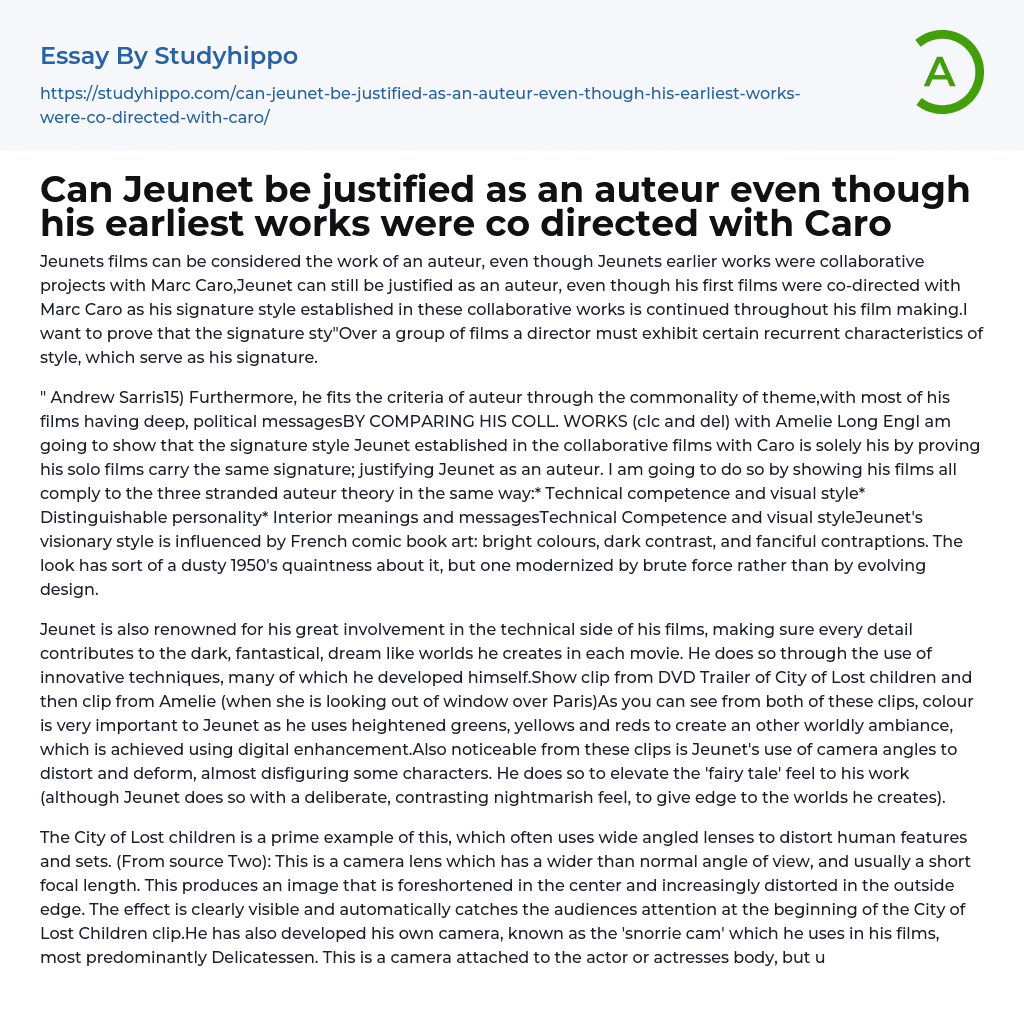Despite collaborating with Marc Caro on his earlier works, Jeunet's films can still be labeled as the work of an auteur. This is due to the fact that his signature style developed during these collaborative projects has remained consistent throughout his career. As a director, he exhibits certain recurrent characteristics of style that serve as his signature over a group of films.
Comparing the collective works of Jeunet with Caro to Amelie, it is evident that Jeunet deserves to be considered an auteur. This is because Jeunet's signature style is consistent in both his collaborative and solo films, which aligns with the three principles of the auteur theory. Jeunet's technical competence and unique visual style draws inspiration from French comic book art, featuring vivid color palettes, high contrast, and imaginative inventions. Although reminiscent of a bygone era, his
...style is modernized through forceful design, establishing Jeunet as a distinguished personality with interior meanings and messages throughout his works.
Jeunet is well-known for his active involvement in the technical aspect of his films. He ensures that every aspect of his movies contributes to the dark, dreamlike worlds he creates. To achieve this effect, he employs innovative techniques that he has developed himself. A clip from the DVD trailer for City of Lost Children and a scene from Amelie (where she gazes out of a window over Paris) demonstrate this fact. Jeunet places great importance on color, using heightened greens, yellows, and reds that are digitally enhanced to create an otherworldly atmosphere. He also distorts and deforms characters using camera angles in both clips to heighten the fairytale-like nature of his work. While Jeunet does contrast his work wit
a deliberately nightmarish feel, overall, his quirks only add edge to the imaginative environments he imagines.
The City of Lost Children utilizes wide angled lenses to distort human features and sets, making it a prime example. According to source Two, these camera lenses have a wider than normal angle of view and produce foreshortened images in the center that increasingly become distorted towards the outer edges. This effect catches the attention of the audience at the start of the City of Lost Children clip. Additionally, director Jean-Pierre Jeunet created his own camera called the 'snorrie cam' that attaches to actors and actresses, giving the audience a direct and personal experience by expressing each movement. This camera is most prominently used in Delicatessen and differs from a steadicam, which absorbs all movement.
Show a clip from Delicatessen featuring the use of snorriecam and an extreme close up of the face. The technical skills of Jeunet were acknowledged at the 2002 Oscars where Amelie, a movie directed by him, was a nominee for five accolades. According to Delbonnel, Jeunet described the film as a happy one during their initial conversation and wanted the viewers to feel uplifted while watching it. He envisioned a fairy tale-like appearance for the film.
During preproduction, Jean-Pierre and the team discussed the desired outcome for the images. He wanted dark blacks and saturated colors while maintaining other areas of the frame. When Duboi introduced a new service for achieving this effect digitally, Jean-Pierre knew he wanted real blues, greens, and golden yellows. Delbonnel shares an example of a scene filmed on a rainy day in Paris that they wanted to enhance.
In the background of
the shot, the sky had an almost white appearance while a building wall was quite dark. The colorist was instructed to use four or five Power Windows to adjust the colors of various elements in the frame. This included fine-tuning the colors of the sky and building wall, enhancing rain droplets on the ground, and deepening the greenish and reddish hues of a grocery store facade. Jeunet's distinct style is easily identifiable, with 75% of surveyed individuals able to distinguish it from other contemporary French films during primary research.
Jeunet's work has attracted both fans who are familiar with his style, as well as newcomers. His films are distinguished by their use of vivid colors, unconventional camera angles, creative editing, meticulous attention to detail, complex devices, and a pervasive otherworldly, fantastical atmosphere. At the heart of all Jeunet's movies is a single recurring theme: dreams. A comparison of clips from Delicatessen and A Very Long Engagement illustrates this theme. Jeunet recognizes his unique style and attributes his success to it. In an interview (SOURCE 1), he remarked, "I think I am the only director in the French language whose films are released everywhere in the world... Maybe I am lucky."
"Perhaps it is due to my films' emphasis on visuals," Jeunet suggests, as his whimsical storylines have garnered global appeal.
- Wall Street essays
- Dead Poets Society essays
- A beautiful mind essays
- Sherlock Holmes essays
- Our day out essays
- American Beauty essays
- Do The Right Thing essays
- Forrest Gump essays
- Good Will Hunting essays
- Finding Forrester essays
- Looking For Alibrandi essays
- On The Waterfront essays
- One Flew Over The Cuckoo'S Nest essays
- Rabbit Proof Fence essays
- Remember The Titans essays
- Schindler'S List essays
- Shawshank Redemption essays
- The Blind Side essays
- Titanic essays
- Witness essays
- The Veil essays
- Blade Runner essays
- Monster essays
- The Graduate essays
- Twilight essays
- West Side Story essays
- Like Water For Chocolate essays
- Glory essays
- Superman essays
- Moulin rouge essays
- American Films essays
- Cinema Of The United States essays
- English-Language Films essays
- Film Editing essays
- Film Noir essays
- Film Techniques essays
- Horror essays
- Bollywood essays
- The time essays
- Saving private ryan essays
- The hunger games essays
- Comedies essays
- Gattaca essays
- King kong essays
- Melodrama essays
- Resident essays
- Subject matter essays
- The blind essays
- The corner essays
- The godfather essays




